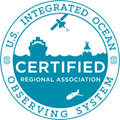Cumulative Wind Stresses for Oregon
Cumulative wind stresses relevant for Oregon coastal upwelling research are publicly available here. These are similar to the cumulative wind stress products used in Barth et al. (2007) and Pierce et al. (2006); some details differ.
Alongshore wind stress cumulative from the spring transition represents energy input into the upwelling system over the course of each season. This has been found to be strongly correlated with a number of different upwelling metrics (Pierce et al., 2006), eg. NH-line surface-layer temperature (0-30m).
Wind stress here is derived from observed winds from the NOAA C-MAN (NWPO3) at Newport, Oregon using the method of Large and Pond (1981). The hourly data are low-pass filtered to remove diurnal variations. The spring and fall transitions (Huyer et al., 1979) are estimated for each year from the alongshore wind stress record, using a CUSUM algorithm for change-point detection (Page, 1954; Gustafsson, 2000). The significance (95%) of these two mean-shift change-points within each year's time series is confirmed using bootstrapping, as suggested by Hinkley and Schechtman (1987).
We hope that researchers will find it useful to compare their own upwelling-related data to the general development of upwelling represented by this cumulative wind stress product. Plots and data access are available via the links to the left.
References
Barth, J. A., B. A. Menge, J. Lubchenco, F. Chan, J. M. Bane, A. R. Kirincich, M. A. McManus, K. J. Nielsen, S. D. Pierce, and L. Washburn (2007) Delayed upwelling alters nearshore coastal ocean ecosystems in the northern California current, Proceedings of the National Academy of Sciences, 104, 3719-3724.
Gustafsson, F. (2000) Adaptive filtering and change detection, John Wiley.
Hinkley, D. and E. Schechtman (1987) Conditional bootstrap methods in the mean-shift model. Biometrika, 74, 85-93.
Huyer, A., E. J. C. Sobey, and R. L. Smith (1979) The spring transition in currents over the Oregon continental shelf. J. Geophys. Res., 84, 6995-7011.
Large, W. G. and S. Pond (1981) Open ocean momentum flux measurements in moderate-to-strong winds. J. Phys. Oc., 11, 324-336.
NOAA Station NWPO3: https://www.ndbc.noaa.gov/station_page.php?station=nwpo3
Page, E. S. (1954) Continuous inspection schemes. Biometrika, 41, 100-115.
Pierce, S. D., J. A. Barth, R. E. Thomas, and G. W. Fleischer (2006) Anomalously warm July 2005 in the northern California Current: historical context and the significance of cumulative wind stress, Geophys. Res. Letters, 33, L22S04, doi:10.1029/2006GL027149.
Acknowledgment
Courtesy of Jack Barth, Steve Pierce, and Jace Marquardt (Oregon State University) (for questions, please contact jack.barth@oregonstate.edu)
Supported by the National Science Foundation (OCE-0435619).
| National Observing System Partners Alliance for Coastal Technologies (ACT) Southeastern Universities Research Association (SURA) Integrated Ocean Observing System IOOS | |||||||

